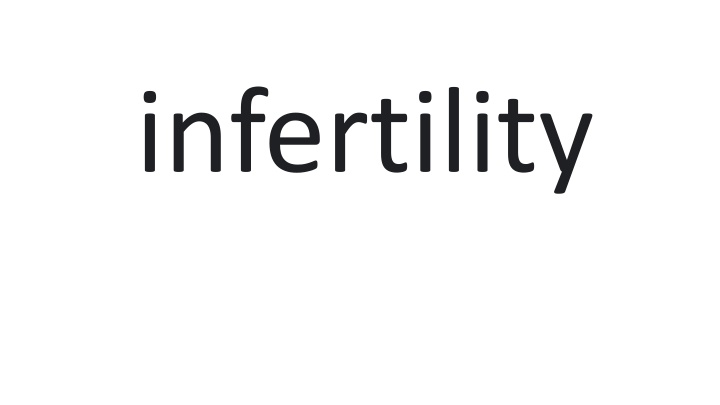
Infertility
Infertility is a common reproductive health issue that can affect both men and women. Learn about the different types of infertility, common symptoms, and possible causes of male infertility. Seek early evaluation and treatment to improve your chances of conceiving.
Download Presentation

Please find below an Image/Link to download the presentation.
The content on the website is provided AS IS for your information and personal use only. It may not be sold, licensed, or shared on other websites without obtaining consent from the author. If you encounter any issues during the download, it is possible that the publisher has removed the file from their server.
You are allowed to download the files provided on this website for personal or commercial use, subject to the condition that they are used lawfully. All files are the property of their respective owners.
The content on the website is provided AS IS for your information and personal use only. It may not be sold, licensed, or shared on other websites without obtaining consent from the author.
E N D
Presentation Transcript
What is infertility? In general, infertility is defined as not being able to get pregnant (conceive) after one year (or longer) of unprotected sex. Because fertility in women is known to decline steadily with age, female partner are over the age of 35, you should see a fertility specialist after six months. After age 40, we recommend seeking help right away because we know fertility declines as age increases
There are 2 types of infertility: Primary infertility refers to couples who have not become pregnant after at least 1 year having sex without using birth control methods. Secondary infertility refers to couples who have been able to get pregnant at least once, but now are unable
Symptoms The main symptom of infertility is not getting pregnant. There may be no other obvious symptoms. Sometimes, women with infertility may have irregular or absent menstrual periods. In some cases, men with infertility may have some signs of hormonal problems, such as changes in hair growth or sexual function. Most couples will eventually conceive, with or without treatment
All of the steps during ovulation and fertilization need to happen correctly in order to get pregnant. Sometimes the issues that cause infertility in couples are present at birth, and sometimes they develop later in life. Infertility causes can affect one or both partners. Sometimes, no cause can be found.
causes of male infertility These may include: Abnormal sperm production or function due to undescended testicles, genetic defects, health problems such as diabetes, or infections such as chlamydia, gonorrhea, mumps or HIV. Enlarged veins in the testes (varicocele) also can affect the quality of sperm.c Problems with the delivery of sperm due to sexual problems, such as premature ejaculation; certain genetic diseases, such as cystic fibrosis; structural problems, such as a blockage in the testicle; or damage or injury to the reproductive organs. Overexposure to certain environmental factors, such chemicals, and radiation. Cigarette smoking, alcohol, , anabolic steroids, and taking medications to treat bacterial infections, high blood pressure and depression also can affect fertility. Frequent exposure to heat, , can raise body temperature and may affect sperm production. Damage related to cancer and its treatment, including radiation or chemotherapy. Treatment for cancer can impair sperm production, sometimes severely
Causes of female infertility Causes of female infertility may include: Ovulation disorders, These include hormonal disorders such as polycystic ovary syndrome. Hyperprolactinemia, . (hypothyroidism) can affect the menstrual cycle or cause infertility. Other underlying causes may include too much exercise, eating disorders or tumors. Uterine or cervical abnormalities, including abnormalities with the cervix, shape of the uterus. (uterine fibroids) may cause infertility by blocking the fallopian tubes or stopping a fertilized egg from implanting in the uterus. Fallopian tube damage or blockage, inflammation of the fallopian tube (salpingitis). This can result from pelvic inflammatory disease, which is usually caused by a sexually transmitted infection, adhesions. Endometriosis, which occurs when endometrial tissue grows outside of the uterus, may affect the function of the ovaries, uterus and fallopian tubes.
Primary ovarian insufficiency (early menopause), when the ovaries stop working and menstruation ends before age 40. Although the cause is often unknown, certain factors are associated with early menopause, including immune system diseases, certain genetic conditions such as Turner syndrome or carriers of Fragile X syndrome, and radiation or chemotherapy treatment. Pelvic adhesions, bands of scar tissue that bind organs that can form after pelvic infection, appendicitis, endometriosis or abdominal or pelvic surgery. Cancer and its treatment. Certain cancers particularly reproductive cancers often impair female fertility. Both radiation and chemotherapy may affect fertility
Risk factors Many of the risk factors for both male and female infertility are the same. They include: Age. Women's fertility gradually declines with age, especially in the mid-30s, and it drops rapidly after age 37. Infertility in older women is likely due to the lower number and quality of eggs, and can also be due to health Tobacco use. Alcohol use. Being overweight. . , o Exercise issues
Diagnosis Tests for men Semen analysis Hormone testing Genetic testing. Testicular biopsy. Imaging. In certain situations, imaging studies such as a brain MRI, transrectal or scrotal ultrasound, or a test of the vas deferens (vasography) may be performed Tests for women Ovulation testing Hysterosalpingography. Ovarian reserve testing. Other hormone testing. levels of ovulatory hormones, as well as pituitary hormones that control reproductive processes. Imaging tests. Pelvic ultrasound looks for uterine or ovarian disease Laparoscopy.
There are 3 main types of fertility treatment: medicines. surgical procedures. assisted conception including intrauterine insemination (IUI) and in vitro fertilisation (IVF)
Fertility Treatments 3 treatments commonly used for This overview of the most common fertility treatments available, including IUI and IVF, will help you understand your options and decide on next steps. Intrauterine insemination (IUI) In vitro fertilization (IVF) Donor eggs. Gestational carrier (surrogacy) Egg freezing. Fertility drugs. What is the first treatment for infertility? Clomiphene citrate 100mg with artificial insemination (IUI) remains the first line treatment of choice for unexplained infertility.
If your irregular ovulation is caused by polycystic ovary syndrome (PCOS), the drug Metformin can also be an option Hormone shots also come with a slight risk of ovarian hyperstimulation syndrome, where the ovaries become swollen and painful.
Fertility drugs are taken at the start of IVF, but you can also take them on their own for ovulation issues. Oral meds like Clomid and letrozole are used to stimulate the ovaries and correct irregular ovulation. Both drugs work by suppressing estrogen production, which boosts the production of ovulation- stimulating hormones. If oral medications don t work, there are hormone shots called gonadotropins that directly stimulate ovulation.















